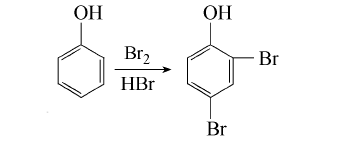2,4-Dibromophenol


Structural formula
| Business number | 06GG |
|---|---|
| Molecular formula | C6H4Br2O |
| Molecular weight | 249 |
| label |
2,4-dibromophenol |
Numbering system
CAS number:615-58-7
MDL number:MFCD00002149
EINECS number:210-436-5
RTECS number:SK8010000
BRN number:1861291
PubChem number:24855633
Physical property data
1. Physical property data
1. Characteristics White crystal with unpleasant odor.
2. Melting point (ºC): 40
3. Solubility Slightly soluble in water, soluble in ethanol, ether, carbon disulfide and benzene.
4. Boiling point (ºC): 238~239
5. Relative density (20℃, 4℃): 2.07
6. Flash point (ºC):>110
Toxicological data
None yet
Ecological data
3. Ecological data:
1. Other harmful effects: This substance may be harmful to the environment, and special attention should be paid to water bodies.
Molecular structure data
5. Molecular property data:
1. Molar refractive index: 43.51
2. Molar volume (cm3/mol): 120.2
3. Isotonic specific volume (90.2K): 323.2
4. Surface tension (dyne/cm): 52.2
5. Polarizability (10-24cm3): 17.25
Compute chemical data
1. Reference value for hydrophobic parameter calculation (XlogP): None
2. Number of hydrogen bond donors: 1
3. Number of hydrogen bond acceptors: 1
4. Number of rotatable chemical bonds: 0
5. Number of tautomers: 3
6. Topological molecule polar surface area 20.2
7. Number of heavy atoms: 9
8. Surface charge: 0
9. Complexity: 97.1
10. Number of isotope atoms: 0
11. Determine the number of atomic stereocenters: 0
12. Uncertain number of atomic stereocenters: 0
13. Determine the number of chemical bond stereocenters: 0
14. Number of uncertain chemical bond stereocenters: 0
15. Number of covalent bond units: 1
Properties and stability
Properties and stability:
1. The product may not decompose under normal temperature and pressure.
2. Exist in mainstream smoke.
3. Toxic and irritating.
Storage method
Storage:
Seal the container and store it in a sealed main container in a cool, dry place.
Synthesis method
Weigh 23.5g (0.25mol) phenol and 70g hydrobromic acid (relative density 1.49), heat slightly to dissolve the phenol, and then use an ice-salt bath to cool to -10°C. Keep the temperature below 10°C and slowly add a mixture of 80g (0.5mol) bromine and 40g hydrobromic acid (pay attention to ventilation). After the addition is completed, maintain it at 0°C for 1 hour, and then heat to 30°C until the bromine color fades. Let it stand for 3 hours, pour off the supernatant, and wash the remaining dibromophenol with warm water several times and dry it in a vacuum dryer to obtain 55g of crude product (88%) with a melting point of 37~38°C. Recrystallize once in low-boiling petroleum ether to obtain pure product, melting point 40℃. 
Purpose
Used as an intermediate in organic synthesis.